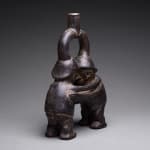Chimu Blackware Stirrup Vessel in the Form of Two Men Wrestling, 800 CE - 1200 CE
Terracotta
height 24.1 cm
height 9 1/2 in
height 9 1/2 in
PF.1880
Further images
The Chimu culture arose around 800 A.D. and flourished until the Incan conquest about six hundred years later. Their civilization was centered at their capital Chan Chan, about 300 miles...
The Chimu culture arose around 800 A.D. and flourished until the Incan conquest about six hundred years later. Their civilization was centered at their capital Chan Chan, about 300 miles north of Lima, literally meaning “Sun Sun,” the largest Pre-Columbian city in Peru estimated to contain almost one hundred thousand citizens. The Chimu believed the sea, which they called “Ni,” was the origin of life, a theory also proposed by modern science and evolution. Thanks to their sea-faring skills, the Chimu were able to survive, nestled in between the desert and the sea. The sea was everything to them: an endless supply of food and the source of inspiration for their most imaginative myths, legends, and artwork. Agriculture was also vital, and the Chimu drew up a vast number of irrigation works demonstrating immense engineering skill, some of which are still in use today. Today, aside from the astounding mud ruins of Chan Chan remarkably well preserved in the heat of the desert, the Chimú are perhaps best known for their distinctive black glazed pottery influenced by their predecessors: the Moche.
The sport of wrestling is as old as civilization itself. Combat without weapons, it pits warrior against warrior in a test of physical strength and quick wits. Wrestling contests are depicted on the walls of Egyptian an Etruscan tombs, on Greek vases, in Chinese sculptures. The sport is as popular today as it has been for thousands of years. This fascinating Chimu vessel depicts two wrestlers at the start of their battle. It is uncertain whether wrestling carried a ritual connotation in Ancient Peru, or merely a sporting one. Evenly matched, wearing helmets and short tunics, they stare eye to eye, locked in an eternally undecided contest. The artist has created a timeless image of human struggle, a metaphor for the contest of life.
The sport of wrestling is as old as civilization itself. Combat without weapons, it pits warrior against warrior in a test of physical strength and quick wits. Wrestling contests are depicted on the walls of Egyptian an Etruscan tombs, on Greek vases, in Chinese sculptures. The sport is as popular today as it has been for thousands of years. This fascinating Chimu vessel depicts two wrestlers at the start of their battle. It is uncertain whether wrestling carried a ritual connotation in Ancient Peru, or merely a sporting one. Evenly matched, wearing helmets and short tunics, they stare eye to eye, locked in an eternally undecided contest. The artist has created a timeless image of human struggle, a metaphor for the contest of life.
Literature
V5





